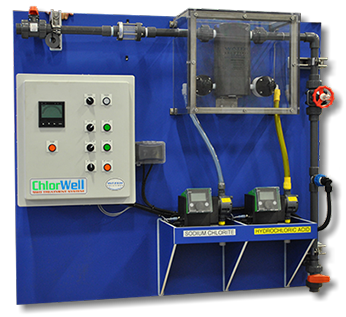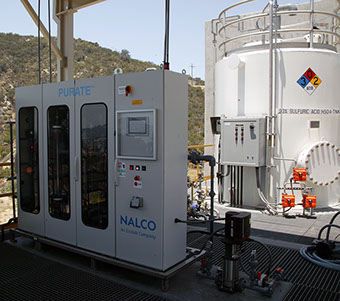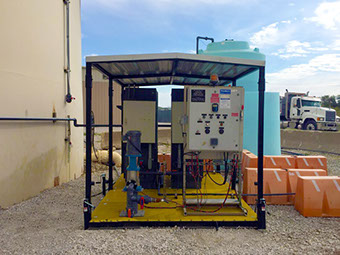Chlorine Dioxide (ClO2)
What is ClO2?
Chlorine dioxide (ClO2) is a powerful yet selective oxidizing agent. It is a greenish yellow gas at room temperature that is very soluble in water.
Unlike chlorine, chlorine dioxide is not a chlorinating agent and pure chlorine dioxide does not form trihalomethanes (THMs), an environmental pollutant that is considered carcinogenic. ClO2 does not chlorinate organics. It also doesn't react with water to form free chlorine or react with ammonia to form chloramine. Additionally, ClO2 is soluble in water and has efficacy across a broad pH range.
Differentiating Factors
One of the most important properties of ClO2 that sets it apart from chlorine is its behavior when placed in water. Not only is ClO2 10 times more soluble in water than chlorine (3.01 grams/Liter at 25 degrees C), it doesn't hydrolyze when placed in solution. It remains as a "true" dissolved gas that retains its useful oxidative and biocidal properties throughout the entire 2 to 10 pH range.
By way of contrast, chlorine dissociates when placed in water to form hypochlorous and hydrochloric acids. Hypochlorous acid is the primary biocide in solution, which dissociates to form hypochlorite ion with increasing pH. Hypochlorite ion is only from 1/20 to 1/300 as effective in controlling microbes as hypochlorous acid. Thus, chlorine can only be an effective biocide in systems with low pH.
The high degree of solubility exhibited by ClO2 in water has also been observed in a variety of organic materials, such as oils and solvents, thereby allowing for utilization of its unique oxidative and biocidal properties in a wide range of potential applications.
Many Applications
Because ClO2 always exists as a true gas under standard conditions of temperature and pressure, whether in open air or dissolved in solution, its antimicrobial properties can be harnessed for either liquid or gaseous application. The "free radical" property of ClO2 makes it particularly useful for addressing structural microbial contamination problems. Liquid ClO2 solution can be applied directly to known areas of microbial contamination, or entire contaminated structures can be fumigated with the gas by simply stripping it back out of solution at the point of application. Once applied, ClO2 quickly decays on its own to invisible, harmless concentrations of various sodium salts including chlorite, chlorate, and chloride ion.
An Effective Biocide
The propensity of ClO2 to react by oxidation rather than substitution makes it a useful alternative to chlorine in drinking water disinfection applications where the formation of potentially carcinogenic halogenated disinfection byproducts, such as triholomethanes and halogenated acidic acids, is of concern. Additionally, ClO2 does not produce significant amounts of aldehydes, ketons, keton acids, or other disinfection byproducts that originate from ozonation of water containing organic substances.
The reaction of ClO2 with microorganisms or other oxidizable substances takes place in two steps. In the first stage of the reaction, the ClO2 molecule accepts an electron and chlorite ion is formed (ClO2-). In the second stage, ClO2 accepts 4 electrons and chloride ion (Cl-) is formed.
The mechanism of action by which ClO2 inactivates microorganisms is not entirely well understood. As a general matter, however, it is known that ClO2 destroys microbes by attacking their cell walls (or viral envelopes) and interfering with essential protein formation. It is also known that ClO2 is more effective against viruses than either chlorine or ozone. Furthermore, ClO2 is known to be effective against hearty waterborne protozoans such as Giardia Lambia and Cryptosporidium, the causative agents of giardiasis and cryptosporidiosis, respectively. Since ClO2 is an oxidative biocide, microorganisms cannot build up a resistance to it.



Properties
High purity ClO2 has a number of physical and chemical properties that make it the ideal product for addressing liquid, surface and/or airborne microbial contamination in a safe and effective manner.
Among the properties that make ClO2 the agent of choice for addressing microbial contamination are the following:
- ClO2 has a long history of effective use as a biocide in a variety of liquid and surface treatment applications including drinking water disinfection, wastewater disinfection, food plant sanitation, pharmaceutical and medical device sterilization, biomedical waste treatment, and cooling water system treatment. The effectiveness of gaseous ClO2 has also been well documented in numerous large-scale fumigation applications.
- ClO2 remains a "true" gas when placed into water or other solution. This means that ClO2 retains its distinct chemical structure and properties after being dissolved, just like carbon dioxide does when dissolved in a can of soda pop. This property has important implications for both treatment efficacy and safety.
- ClO2 is highly soluble in water as well as in a variety of organic materials. Because it is so soluble, ClO2 penetrates through materials that protect microorganisms from other biocides. For example, in water systems, bacteria can be protected by a polysaccharide film. Chlorine has difficulty penetrating this barrier because of its ionic nature in water. ClO2 readily penetrates through this layer to kill underlying organisms. This quality makes ClO2 highly effective in controlling cooling tower biofilms. Another example of its extreme liquid solubility and penetrability occurs in the petroleum production environment where ClO2 in used to penetrate through a hydrocarbon layer to oxidize contaminants and kill bacteria being shielded by the hydrocarbon material.
- ClO2 has more than twice the oxidative capacity of chlorine, but has lower oxidation strength. Because ClO2 has lower oxidation strength, it is more selective in its reactions. Typically, ClO2 will react with compounds that have activated carbon bonds such as phenols, or with other active compounds like sulfides, cyanides, and reduced iron and manganese compounds. Because chlorine is a more powerful oxidizer that ClO2, it will react with a wider variety of chemicals, including ammonia. This property limits the overall effectiveness of chlorine as a biocide.
- ClO2 exists as a gas under standard temperature and pressure (STP) conditions. Many potential fumigants, such as hydrogen peroxide and formaldehyde, are vapors, meaning they are in a liquid state at STP conditions and must be continually heated to keep them in an effective gaseous form. This property greatly limits their fumigation utility to very small areas where the required high temperature conditions can be maintained. Conversely, ClO2 can be used to fumigate structures of any size with a single application, and has been proven effective in buildings as large as 14 million ft3.
- ClO2 doesn't need to be removed from surfaces or air spaces following treatment. Because it is a "free radical" molecule, ClO2 decays naturally on its own, whether applied in liquid or gaseous form.
- ClO2 doesn't leave any visible or harmful residues on surfaces following treatment. Any ClO2 that is applied as part of either a liquid or gaseous treatment decays quickly to harmless concentrations of various sodium salts including chlorite, chlorate, and chloride.
ClO2 is a small, volatile, and very strong molecule that reacts with other substances by way of oxidation rather than by substitution (i.e. chlorination). ClO2 has lower oxidation strength than chlorine, but more than twice the oxidative capacity.
MENU

© AZURE WATER SERVICES, LLC — 2018 — ALL RIGHTS RESERVED

